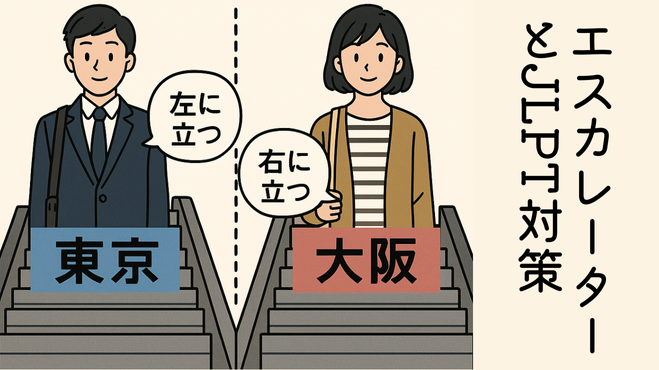1. イントロ|Introduction(日本語・英語・韓国語)
?? 日本語
日本では、エスカレーターに乗るときに「立つ側」が地域によって違うって知っていましたか?東京では左側に立ち、大阪では右側に立つのが普通です。この違いは、日本に初めて来た人が驚く文化のひとつ。この記事では、やさしい日本語(N5〜N1)でこのマナーと背景を紹介し、日本語学習にも役立つ語彙・文法を解説します。
?? English
Did you know that in Japan, which side you stand on an escalator depends on the region? In Tokyo, people stand on the left. In Osaka, they stand on the right. It’s one of the surprising cultural differences for newcomers. This article explains the reason behind it using easy Japanese (N5–N1 level) and includes helpful vocabulary and grammar points.
?? 한국어
일본에서는 에스컬레이터를 탈 때 어느 쪽에 서는지가 지역마다 다르다는 걸 아시나요? 도쿄에서는 왼쪽에 서고, 오사카에서는 오른쪽에 서는 것이 일반적입니다. 외국인들이 놀라는 문화 차이 중 하나입니다. 이 글에서는 쉬운 일본어(N5~N1 수준)로 이 차이를 소개하고, 어휘와 문법도 함께 배울 수 있어요。
2. Vocabulary|語彙|어휘
| 日本語(ふりがな) | English | 한국어 |
|---|---|---|
| エスカレーター | escalator | 에스컬레이터 |
| 右(みぎ) | right | 오른쪽 |
| 左(ひだり) | left | 왼쪽 |
| 立つ(たつ) | to stand | 서다 |
| 歩く(あるく) | to walk | 걷다 |
| 地域(ちいき) | region | 지역 |
| マナー | manners | 매너 |
| ちがい | difference | 차이 |
3. Grammar Notes|文法ポイント|문법 설명
| 文型・表現 | 日本語の説明 | 英語 | 한국어 |
|---|---|---|---|
| ~では | 「場所+では」=その場所では | in (place) | ~에서는 |
| ~がちがいます | 「違う」という表現 | to be different | ~이 다르다 |
| ~のほうが〜です | 比較表現(〜の方が〜より〜) | ~ is more … than … | ~쪽이 더 ~하다 |
4. N5〜N1 レベル本文(修正版)
N5
??
とうきょうでは ひだり に たちます。おおさかでは みぎ に たちます。
??
In Tokyo, people stand on the left. In Osaka, they stand on the right.
??
도쿄에서는 왼쪽에 서고, 오사카에서는 오른쪽에 서요。
N4
??
日本では、地域によって エスカレーターの マナーが ちがいます。
??
In Japan, escalator manners are different depending on the region.
??
일본에서는 지역마다 에스컬레이터 매너가 달라요。
N3
??
東京では左側に立ち、右側を歩く人が多いですが、大阪では右側に立ち、左側を歩きます。
??
In Tokyo, people stand on the left and walk on the right, while in Osaka, people stand on the right and walk on the left.
??
도쿄에서는 왼쪽에 서고 오른쪽으로 걷고, 오사카에서는 오른쪽에 서고 왼쪽으로 걸어요。
N2
??
このようなマナーの違いは、関東と関西の文化差の一つとして知られています。
??
This difference in manners is known as one of the cultural differences between eastern and western Japan.
??
이런 매너의 차이는 관동과 관서 지역의 문화 차이 중 하나로 알려져 있어요。
N1
??
エスカレーターの立ち位置の違いには、鉄道会社の歴史や混雑緩和の工夫といった背景があると考えられています。
??
The difference in where to stand on escalators is said to be influenced by railway company history and efforts to ease congestion.
??
에스컬레이터에서 서는 위치 차이는 철도 회사의 역사와 혼잡 완화를 위한 배려에서 비롯된 것으로 여겨집니다。
5. トリビア・豆知識(修正版)
- なぜ大阪は右立ち?
→ 阪急電鉄など関西の私鉄が「右立ち・左歩き」を推奨していた影響とされます。 - 東京はなぜ左立ち?
→ 国鉄(現在のJR東日本)で導入された初期エスカレーターが「左立ち・右歩き」だったため、今も引き継がれています。 - 京都では?
→ 地元住民は関西式「右立ち」、観光客は東京式「左立ち」で混在し、カオスになることも。 - 最近の流れ:歩かない運動も拡大中
→ エスカレーターでは「歩かず立ち止まろう」という安全運動も全国で広がりつつあります。
Trivia|トリビア(英語版)
- Why does Osaka use the right side?
→ Some say it’s because Kansai private railways like Hankyu promoted standing on the right and walking on the left. - Why is Tokyo left side standing?
→ The national railway (now JR East) introduced early escalators with left-side standing, and the custom remained. - What about Kyoto?
→ In Kyoto, locals follow Kansai style (right standing), but tourists from Tokyo stand on the left—often leading to confusion. - Recent trend: Don’t walk campaigns
→ Nationwide campaigns now encourage people to stand still on escalators for safety reasons, discouraging walking.
트리비아|トリビア(韓国語+日本語訳)
- 오사카는 왜 오른쪽에 설까요?
→ 간사이 지역의 사철, 특히 한큐 전철 등이 오른쪽에 서고 왼쪽으로 걷는 습관을 권장했던 영향입니다。
→ 関西の私鉄、特に阪急電鉄などが「右立ち・左歩き」を推奨していた影響です。 - 도쿄는 왜 왼쪽에 설까요?
→ 구 국철(현재의 JR 동일본)에서 왼쪽에 서는 에스컬레이터를 초기에 도입했기 때문에, 지금도 그 습관이 남아 있습니다。
→ 旧国鉄(現在のJR東日本)で導入された左立ちのエスカレーターの影響が続いています。 - 교토는 어떤가요?
→ 교토에서는 현지인은 오른쪽에 서고, 관광객은 왼쪽에 서서, 때때로 혼란이 생깁니다。
→ 京都では、地元の人は右に、観光客は左に立ち、混乱することがあります。 - 최근에는 ‘걷지 않기’ 운동도 진행 중입니다
→ 전국적으로 에스컬레이터에서 걷지 않고 멈춰 서자는 안전 캠페인이 확대되고 있습니다。
→ 全国的に「歩かずに止まりましょう」という安全運動が広がっています。
6. まとめ|Summary(修正版)
エスカレーターで立つ側が違うという文化の違いは、短期間の旅行者にとっても、長期滞在する学習者にとっても面白く、日常生活に密着したマナーの一つです。このような地域差に気づくことで、より深く日本を理解できます。
次にエスカレーターに乗るとき、あなたはどちらに立ちますか?
Summary|まとめ(英語版)
The difference in where people stand on escalators is a unique and often surprising part of daily Japanese culture. It’s something you may not notice at first—but once you do, it becomes a great conversation starter. Understanding these local habits helps deepen your cultural understanding.
Next time you’re on an escalator in Japan, which side will you stand on?
요약|まとめ(韓国語+日本語訳)
일본의 에스컬레이터에서 어느 쪽에 서는지는, 지역에 따라 다른 흥미로운 문화입니다。
→ 日本のエスカレーターで立つ側は、地域によって異なる興味深い文化です。
처음엔 눈치채기 어려울 수 있지만, 알게 되면 대화의 소재가 되기도 해요。
→ 最初は気づきにくいですが、知ると話題にもなります。
이런 작은 차이를 이해하는 것이야말로 일본 문화를 깊이 있게 배우는 첫걸음입니다。
→ こうした小さな違いを理解することこそ、日本文化を深く学ぶ第一歩です。
당신은 다음에 에스컬레이터에서 어느 쪽에 설 건가요?
→ あなたは次、どちら側に立ちますか?


